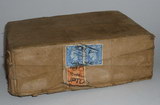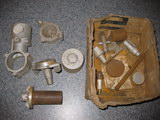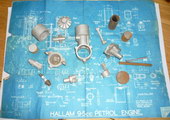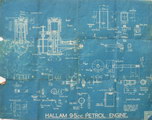Hallum 9.5cc Petrol Engine
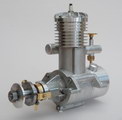 |
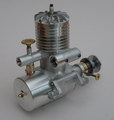 |
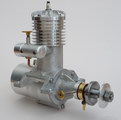 |
Click on images to view larger picture.
The company, J Hallum and Sons, of Poole, Dorset (UK), was a pioneer of model internal combustion engines and casting kits during the nineteen-forties. All of their designs were piston ported (aka "side-port"), and with the exception of a single, short-lived 2.5cc diesel introduced in 1947, all were spark ignition engines. Displacements of the sparkies varied between 3 and 13.5cc, although there was a 5cc in-line twin, meaning each cylinder would have been of 2.5cc displacement. The company did sell finished engines, but all were offered as kits, so today, the variation in known examples is quite broad, owing to the innovativeness of individual builders. The company found that post-war sales were poor, and as they were busy with other things, all the model engine patterns were burnt about 1952/3. The company itself followed, metaphorically, around 1955.
The engine pictured above carries the attractive and memorable name, Hallum 9.5cc Petrol Engine, this being the title on the blue print (and yes, it was a true "blue print"). The engine was built in 2013 from an original kit by Jan Huning who was lucky enough to be given the original kit, in the original box, with the original postage stamps, by a work colleague who in turn, had got it from his grandfather. Note the stamps, to the tune of seven pence, on the box, bearing the image of King George (he's the one we don't talk about).
The kit comprises sand cast aluminum parts, steel and cast iron barstock, plus the full size plans. The crankshaft is built-up, which is quite practical, provided some care is taken to (1) get the parts alligned accurately, and (2) take steps which prevent auto-disassembly. Take close note of the crankcase and the front and rear cover castings. There are no beam-mounting lugs on the crankcase. Instead, ears cast onto the sides of the front and rear covers provide beam mounting feet. Hallum used this "feature" on their 3cc "Baby", and 5cc in-line twin. Most others had conventional beam mounts, apart from their first design, the 13.5cc engine which was bulkhead mounted by the screws which held the vertically split crankcase together.
The plans clearly show a bore of 0.875" and a stroke of 1.0", which my HP reverse-Polish notation calculator says equates to a displacement of 0.601 cuin, or 9.857cc. Perhaps slide rules were shorter in those days. Jan's "before" shot here shows the steel tube provided for the cylinder liner, and the 3/8" thread sparking-plug provided with the kit.
Here is the "money shot" of model engine building—all the parts arrayed in their naked glory for the camera. The really interesting bits are the ones just above and the the left of the connecting rod. The thing with the hole in the top is the piston. It's basically a thin-wall, cast-iron shell, into which is inserted the gudgeon-pin carrier, seen just above the conrod. It has a threaded stub which protrudes through the top of the piston, onto which is screwed (firmly!) a "nut" which is shaped as a transfer deflecting baffle on one side, sloping down towards the exhaust on the other. Quite practical, but think for a minute how you would arrange to have it tighten up in the correct orientation with relation to the hidden gudgeon pin.
As might be expected from the simple, conventional design, and the excellent machining done by Jan, the old Hallum runs just fine, although Jan notes that it is not the most powerful of beasts. This is probably not a bad thing, given the likely strength of that cast aluminum connecting rod! In fact, Jan was so concerned with the porosity of the castings that he fitted a bush in the main shaft journal. Eagle-eyed readers will have noticed that Jan has cunningly substituted a 1/4" thread spark plug for the original 3/8" monster. If we can believe it, Clanford's A-Z of Model Engines dates the engine as 1944, making it almost 70 years old. But then, the picture of the engine in Clanford (p91) calls it 10cc. Let's be charitable and say it's a rounding error.
Jan has done a fine job on this engine, and has gone to the trouble of having the original plan scanned, full size, for those who might like to try making their own castings and engine. The image here is a reduced size version of the plan. The full size version is rather large, but if you'd like a copy, visit the Model Engine News Plans Index.
